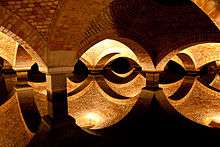Tourist attractions in Warsaw

The city of Warsaw, the capital of Poland, offers a variety of tourist attractions, including historical sights, monuments, museums, theatres, and places connected with Marie Curie, and with Frédéric Chopin and his music.[1][2] Since 1980, the old town, one of the main attractions, has been a UNESCO World heritage site.[1][3]
Major sights
| Old Town & New Town Warsaw Old Town (Starówka)
Warsaw New Town (Nowe Miasto)
|
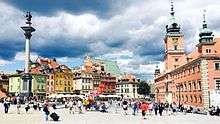
The oldest part of Warsaw, founded at the turn of the 13th century, is the Old Town. Its streets form a regular chessboard pattern typical for medieval towns. Among the most notable landmarks of the Old Town are the Royal Castle, King Sigismund's Column, Market Square, and the Barbican. Another important historic district is the New Town. It was formed at the turn of the 14th century as an independent city and after 1791, due to the tenets of the Constitution of May 3, 1791, was incorporated into Warsaw.

Although today's Warsaw is a fairly young city, it has many tourist attractions. Apart from the Warsaw Old Town quarter, carefully reconstructed after World War II, each borough has something to offer. Among the most notable landmarks of the Old Town are the Royal Castle, King Zygmunt's Column, Market Square, and the Barbican.
Further south is the so-called Royal Route, with many classicist palaces, the Presidential Palace and the Warsaw University campus. Also the popular Nowy Świat Street, one of the principal business streets, is worth mentioning. Wilanów Palace, the former royal residence of King John III Sobieski, is notable for its baroque architecture and beautiful parks.[4]
Warsaw's oldest public park, the Saxon Garden, is located within 10 minutes' walk from the old town.[5] Warsaw's biggest public park and said to be the most beautiful is the Royal Baths Park. It is also very old – established in the 17th century and given its current classical shape in late 18th century[6] – is located further south, on the Royal Route, about 3 km (1.9 mi) from the Warsaw Old Town.
| Wola, Wilanów, Żoliborz Wola Wilanów Żoliborz |
The Powązki Cemetery is one of the oldest cemeteries in Europe,[7] full of sculptures, some of them by the most renowned Polish artists of the 19th and 20th centuries. Since it serves the religious communities of Warsaw, be it Catholics, Jews, Muslims or Protestants, it is often called a necropolis. Nearby is the Okopowa Street Jewish Cemetery, one of the largest Jewish cemeteries in Europe.
In many places in the city the Jewish culture and history resonates down through time.[8] Among them the most notable are the Jewish theater, the Nożyk Synagogue, Janusz Korczak's Orphanage and the picturesque Próżna Street.[8] The tragic pages of Warsaw’s history are commemorated in places such as the Monument to the Ghetto Heroes, the Umschlagplatz, fragments of the Ghetto wall on Sienna Street and a mound in memory of the Jewish Combat Organization.[8]
| Bielany, Praga Bielany
Praga
|
There are also many places commemorating the heroic history of Warsaw.[9] Pawiak, an infamous German Gestapo prison now occupied by a Mausoleum of Memory of Martyrdom and the museum, is only the beginning of a walk in the traces of Heroic City.[9] The Warsaw Citadel, an impressive 19th-century fortification built after the defeat of the November Uprising, was a place of martyr for the Poles.[9] Another important monument, the statue of Little Insurgent located at the ramparts of the Old Town, commemorates the children who served as messengers and frontline troops in the Warsaw Uprising, while the impressive Warsaw Uprising Monument by Wincenty Kućma was erected in memory of the largest insurrection of World War II.[9][10]

After the Warsaw area enlargement in 1916, an occasion was aroused to build new estates. Yet in 20's and 30's new workers' and villas' estates came into existence. Thanks of this the villas' estate was built in Saska Kępa. Most prewar building at this district was not destroyed during war. Nowadays still exists many examples of houses from interwar period, designed by notable architects, like Bohdan Pniewski, Bohdan Lachert, Józef Szanajca, Lucjan Korngold or Szymon and Helena Syrkus.[11]
In Warsaw there are many places connected with the life and work of Fryderyk Chopin. The heart of the Polish-born composer is sealed inside Warsaw's Holy Cross Church.[12] During the summer time the Chopin Monument in the Royal Baths Park is a place where pianists give concerts to the park audience.[13]
Also many references to Marie Curie, her work and her family can be found in Warsaw: Marie's birthplace at the Warsaw New Town, the working places where she did her first scientific works[14] and the Radium Institute at Wawelska Street for the research and the treatment of cancer which she founded in 1925.[15]
| Mokotów, Ursynów Mokotów
Ursynów
|
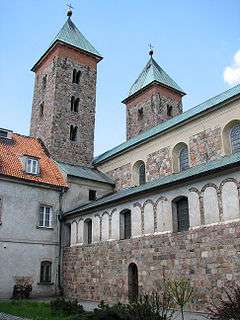
The surroundings of Warsaw also offer many tourist attractions - medieval castles, mansions of the Polish nobles and historic places. Around the city county many medieval monuments can be found including Romanesque church and monastery in Czerwińsk (1129–1156)[16] 52 km (32 mi) west of Warsaw, and Czersk castle (1388–1410)[17] a legendary ruined castle sitting atop an escarpment about 33 km (21 mi) from Warsaw. 16th-century parish church in Brochów at the Bzura River, 52 km (32 mi) west of Warsaw, where Chopin's parents were married (1806) and Fryderyk was baptised is another interesting monument. The church was constructed as a fortified Gothic shrine. Bieliński Palace in Otwock Wielki (1682–1689), 25 km (16 mi) from Warsaw city center, houses the Museum of Interiors while palace in Jabłonna, 18 km (11 mi) north of Warsaw, is a part of an 18th-century elegant palace-and-park complex.[18] Żelazowa Wola about 60 km (37 mi) west of Warsaw is the birthplace of Fryderyk Chopin. The annex of the former 19th-century mansion of the Chopin family was turned into a museum devoted to the composer.[19] A 19th-century health spa in Konstancin-Jeziorna is located about 20 km (12 mi) south of Warsaw.[20] A narrow-gauge train museum in Sochaczew, about 50 km (31 mi) from Warsaw, has the largest collection of narrow-gauge trains in Europe.[21]
References
- 1 2 "Warsaw - the vibrant Capital City". www.poland.travel. Archived from the original on 2008-04-30. Retrieved 2009-04-14. Due to the amazing reconstruction that followed the destruction of World War II, the Old Town was included on the UNESCO World Heritage List in 1980. (...) ... which was once the Museum of Industry and Trade, where Maria Skłodowska-Curie worked before she left for France. (...) In the summer, Chopin’s music can be heard every Sunday at the Chopin monument in Royal Łazienki Park.
- ↑ "Information about Warsaw". www.warsawtour.pl. Retrieved 2009-04-14.
- ↑ "Historic Centre of Warsaw". whc.unesco.org. Retrieved 2008-08-18.
- ↑ "Palace". wilanow-palac.art.pl. Retrieved 2008-02-21.
- ↑ "Ogród Saski". ePrzewodnik (in Polish). Retrieved 2008-02-10.
- ↑ "Historia". www.lazienki-krolewskie.pl (in Polish). Retrieved 2009-01-31.
- ↑ "Short and long history of the Powiązki Cemetery" (in Polish). Retrieved February 11, 2008.
- 1 2 3 "Warsaw Judaica". www.um.warszawa.pl. Retrieved 2010-01-26.
- 1 2 3 4 "Heroic City". www.um.warszawa.pl. Archived from the original on 2013-07-04. Retrieved 2010-01-26.
- ↑ James Ramsay Montagu Butler; Norman Henry Gibbs; J. M. A. Gwyer; John Patrick William Ehrman; Michael Eliot Howard (1976). "History of the Second World War; United Kingdom military series 5". In James Ramsay Montagu Butler. Grand strategy. H. M. Stationery Off. p. 369.
- ↑ Piwowar, Magdalena; Piątek, Grzegorz; Trybuś, Jarosław (2012). SAS. An illustrated Atlas of Saska Kępa ARchitecture. Warsaw: Centrum Architektury. ISBN 978-83-934574-0-3.
- ↑ "Church of the Holy Cross". eGuide / Treasures of Warsaw on-line. Retrieved 2009-02-23.
- ↑ "Frédéric Chopin Monument". eGuide / Treasures of Warsaw on-line. Retrieved 2009-02-23.
- ↑ "Polish Girlhood (1867-1891)". www.aip.org. American Institute of Physics. Retrieved 2009-02-25.
- ↑ "The Radium Institute (1919-1934)". www.aip.org. American Institute of Physics. Retrieved 2009-02-25.
- ↑ "Rys historyczny Czerwińska n.Wisłą i Sanktuarium". www.czerwinsk.salezjanie.pl (in Polish). Archived from the original on 2009-07-07. Retrieved 2009-02-24.
- ↑ "Czersk - ruiny zamku książąt mazowieckich". www.zamkipolskie.com (in Polish). Retrieved 2009-02-24.
- ↑ "Jabłonna Palace". www.palacjablonna.pl. Archived from the original on February 17, 2009. Retrieved 2009-04-10.
- ↑ "Żelazowa Wola - Fryderyk Chopin's Birthplace". en.chopin.nifc.pl. Retrieved 2009-02-23.
- ↑ "Konstancin-Jeziorna". www.staypoland.com. Retrieved 2009-02-24.
- ↑ Przemysław Molik (12 May 2004). "All Aboard!". www.warsawvoice.pl. Archived from the original on November 18, 2004. Retrieved 2009-04-06.
Gallery
City centre
-

Houses on the Kanonia Square
-

The Adam Mickiewicz Statue and the Carmelite Church
-
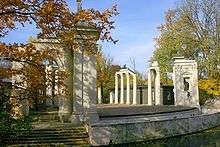
Roman theater on the Isle, a companion to the Palace on the Water
-
.jpg)
Okopowa Street Jewish Cemetery
-

Fryderyk Chopin monument
Warsaw surroundings
-
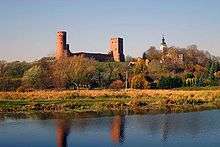
Masovian Dukes Castle in Czersk
-

Fortified Gothic church in Brochów
-
Bieliński Palace in Otwock Wielki
-
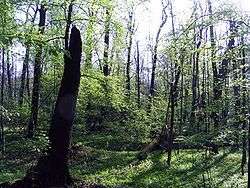
Lasek Bielański - nature reserve
See also
| Wikivoyage has a travel guide for Warsaw. |

